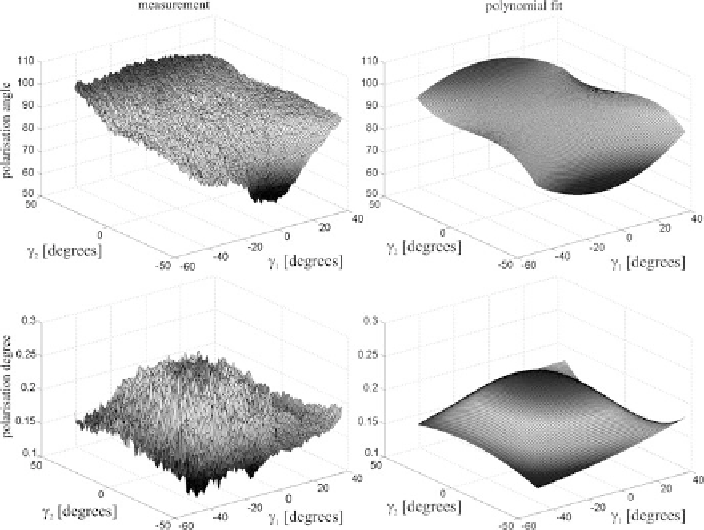Graphics Reference
In-Depth Information
Fig. 3.6
Measured and modelled polarisation properties of a raw forged iron surface at a phase
angle of
α
=
79
◦
.
To p
: Polarisation angle.
Bottom
: Polarisation degree
c
D
γ
1
d
D
γ
2
e
D
γ
1
γ
2
f
D
γ
2
g
D
γ
1
γ
2
R
D
(γ
1
,γ
2
)
=
a
D
+
b
D
γ
1
+
+
+
+
+
+
h
D
γ
1
γ
2
,
(3.61)
which is symmetric in
γ
2
. The symmetry properties are required for geometrical rea-
sons as long as an isotropic interaction between incident light and surface material
can be assumed. The polarisation properties of a raw forged iron surface measured
at a phase angle of
α
79
◦
are illustrated in Fig.
3.6
, along with the polynomial fits
according to (
3.60
) and (
3.61
). Interestingly, while in the framework based on Fres-
nel theory outlined in Sect.
3.4.1
the polarisation angle corresponds to the projection
of the surface normal into the image plane (up to a 90
◦
phase shift for specular po-
larisation), a close inspection of the polarisation angle measurements by d'Angelo
and Wöhler (
2005a
) reveals that this simple relation does not hold for rough metallic
surfaces.
At this point it is straightforward to determine the surface gradients
p
and
q
associated with the goniometer angles
γ
1
and
γ
2
based on the mechanical setup
of the goniometer. Based on the fitted phenomenological laws for the polarisation
angle
Φ
and degree
D
p
, the functions
R
Φ
(p, q)
and
R
D
(p, q)
yielding the polari-
sation properties in terms of the surface gradients
p
and
q
are obtained. In analogy
to the intensity reflectance map
R
I
(p, q)
,
R
Φ
(p, q)
is termed a polarisation angle
=

Search WWH ::

Custom Search